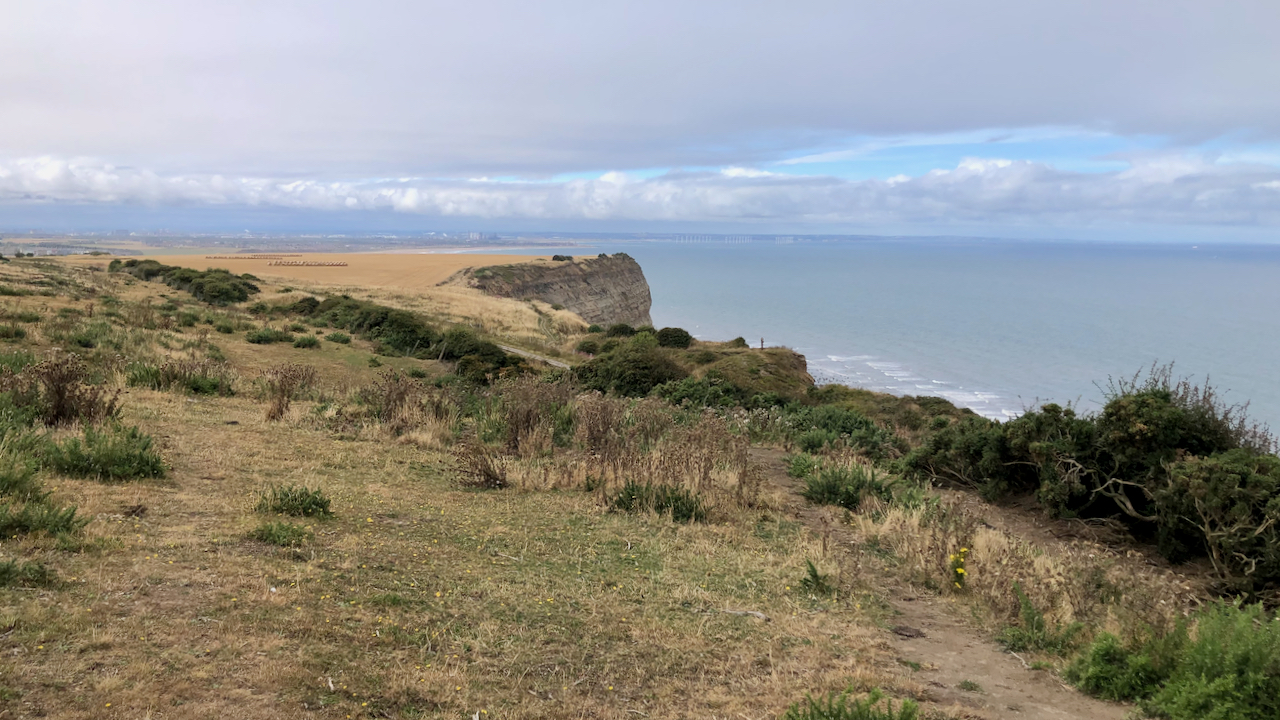One of the lesser known ironstone mines in Cleveland.
Well, actually it was a quarry for the first 8 years of its operation from 1857 to 1865. An account published in 1866 by ‘J.G.’ is interesting1“A Visit to the Sea Cliffs of Cleveland.” Yorkshire Gazette, 14 July 1866, p. 2. British Library Newspapers, http://link-gale-com.ezproxy.is.ed.ac.uk/apps/doc/JF3231097707/GDCS?u=ed_itw&sid=GDCS&xid=a5468420. Accessed 10 Mar. 2021.:
Enchanting as everything appeared we had no time to linger, so we began our trip from the beach and walked onward to Huntcliff, on the way to Whitby. This cliff rises to an elevation of 360 feet, upon which the men at the ironworks of Mr. Morrison are engaged in removing the earth which overlie the ironstone, and filling trucks with the ironstone and taking it away on iron rails by an engine to a depot, from whence it is taken by rails to Middlesbro’ to the blasting furnaces. Whilst some part of the mining had been done by gunpowder explosion, we saw some of the men working at the extreme edge of the cliff removing the earth and rubbish from the surface of the ironstone and throwing it over the cliff; and others with mattocks removing the ironstone and filling the trucks, – a more simple and inexpensive method cannot be conceived. The seam crops out near the surface, and the wealth in iron ore to be extracted from these hills must be in calculable.
There is not much to see, significant areas of broken ground either side of the modern Boulby Potash Railway, formerly the Cleveland Railway. The quoted map reference for the quarry is on the left approximately at the end of the “hedge” of gorse which align the railway2Tuffs, Peter. “Catalogue of Cleveland Ironstone Mines”. Page 10. Cleveland Ironstone Series 1996.
In the early days of operation, before the railway was built, the ironstone was merely thrown over the cliff and shipped from the beach below3Ibid. Page 11.. But ‘J.G.’ records it being “taking it away on iron rails by an engine” so the railway must have at least been complete this far.
1865 was a year of high activity. The application for the extension to the Cleveland Railway was made in November 18644‘Skelton and Parish of Skelton, Otherwise Skelton-Cum- Brotton. Thirdly.—a Railway Commencing the Said Township of Brotton, and Parish of Skelton, | Yorkshire Gazette | Saturday 26 November 1864 | British Newspaper Archive’. 2022. Britishnewspaperarchive.co.uk <https://www.britishnewspaperarchive.co.uk/viewer/bl/0000266/18641126/134/0012> [accessed 29 August 2022]. By 1865, the line had been completed as far as Loftus Bank5“Guisborough Before 1900”. Edited by B.J.D. Harrison and G. Dixon. Page 205. 1982. ISBN 0 9507827 0 X., the Cleveland Railway was taken over by the ever powerful North Eastern Railway Company6Ibid., and the Cliff Ironstone royalty was transferred to Bell Brothers7Tuffs, Peter. “Catalogue of Cleveland Ironstone Mines”. Page 11. Cleveland Ironstone Series 1996.
The ‘Mr. Morrison’ that J.G. refers to is Robert Morrison who was a very succesful businessman from Ouseburn manufacturing marine and other classes of engines, as well as an improved steam-hammer which he had invented and patented8‘Robert Morrison – Graces Guide’. 2021. Gracesguide.co.uk <https://www.gracesguide.co.uk/Robert_Morrison> [accessed 29 August 2022]. His venture into ironstone extraction was perhaps intended to be a diversification in view of the prevailing commercial depression.
However, Tuffs records that Cliff ironstone mine was operated between 1857 and 1865 by a ‘Mr Thomas of John Rigg’s ironstone‘9Tuffs, Peter. “Catalogue of Cleveland Ironstone Mines”. Page 10/11. Cleveland Ironstone Series 1996. What therefore the relationship was between Morrison and Thomas, is unclear.
On the arrival of the railway, two shafts were sunk, on the either side of the line10Ibid. Page 11.. Whoever began this initiative, Thomas/Morrison or Bell Bros., is another unanswered question.
What is clear is that Bell Bros. operated the mine until 1887 when Cliff ironstone was taken out through their Huntcliff mine, 800m away11Ibid. Page 16., which can be identified by the ruined Guibal Fan House. Huntcliff mine closed in 190612Ibid. Page 16..
- 1“A Visit to the Sea Cliffs of Cleveland.” Yorkshire Gazette, 14 July 1866, p. 2. British Library Newspapers, http://link-gale-com.ezproxy.is.ed.ac.uk/apps/doc/JF3231097707/GDCS?u=ed_itw&sid=GDCS&xid=a5468420. Accessed 10 Mar. 2021.
- 2Tuffs, Peter. “Catalogue of Cleveland Ironstone Mines”. Page 10. Cleveland Ironstone Series 1996
- 3Ibid. Page 11.
- 4‘Skelton and Parish of Skelton, Otherwise Skelton-Cum- Brotton. Thirdly.—a Railway Commencing the Said Township of Brotton, and Parish of Skelton, | Yorkshire Gazette | Saturday 26 November 1864 | British Newspaper Archive’. 2022. Britishnewspaperarchive.co.uk <https://www.britishnewspaperarchive.co.uk/viewer/bl/0000266/18641126/134/0012> [accessed 29 August 2022]
- 5“Guisborough Before 1900”. Edited by B.J.D. Harrison and G. Dixon. Page 205. 1982. ISBN 0 9507827 0 X.
- 6Ibid.
- 7Tuffs, Peter. “Catalogue of Cleveland Ironstone Mines”. Page 11. Cleveland Ironstone Series 1996
- 8‘Robert Morrison – Graces Guide’. 2021. Gracesguide.co.uk <https://www.gracesguide.co.uk/Robert_Morrison> [accessed 29 August 2022]
- 9Tuffs, Peter. “Catalogue of Cleveland Ironstone Mines”. Page 10/11. Cleveland Ironstone Series 1996
- 10Ibid. Page 11.
- 11Ibid. Page 16.
- 12Ibid. Page 16.

Leave a Reply